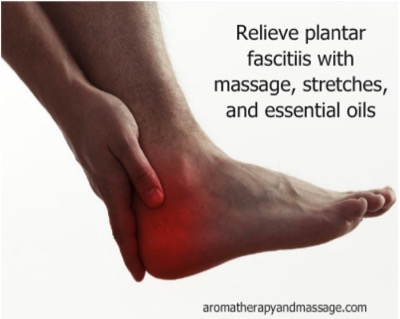- Home
- Benefits of Massage
- Treatment for Plantar Fasciitis
As an Amazon Associate and affiliate with other programs, I may earn revenue from qualifying purchases through affiliate links. This does not affect the price you pay. Privacy Policy / Disclosures. This site is for educational purposes only.
Treatment for Plantar Fasciitis Using Massage and Essential Oils
Massage can be an important part of treatment for plantar fasciitis.
This condition has symptoms that include foot pain, especially around
the heel, that is worse in the morning, after sitting or standing for a
long time, and during the beginning of a sporting activity.

The plantar fascia is a broad band of tissue on the bottom of the foot. This band starts at the heel and runs to the ball of the foot. Plantar fasciitis has often been thought of as a condition caused by chronic inflammation but recent research suggests the condition is due more to the breakdown of collagen in the tissue (often following an episode of inflammation). Collagen is a protein essential to supporting body tissues.
Some sources distinguish between plantar fasciitis, inflammation caused by initial microtears in the fascia, and plantar fasciosis, continuing pain after initial inflammation goes away and the collagen begins to break down.
Let's look at the symptoms and how to use massage and essential oils for plantar fasciitis.
Plantar Fasciitis Symptoms
Here's what happens. Microtears occur in the fascia either because of direct injury or, more commonly, repeated trauma, such as running, sitting at a desk with your heels off the floor for long periods of time, or standing all day, especially on a hard surface. Poorly fitting shoes, especially those with narrow toe boxes, contribute to the problem.
The first symptom of this foot injury is usually dull, intermittent pain in the heel. Often the pain eventually becomes sharp and persistent not only in the heel but also mid-sole or near the toes.
If the plantar fascia sustains a lot of damage, heel spurs (excess bone growth) can develop. Sometimes, plantar fasciitis is called heel spur syndrome. However, the spurs don't cause the initial pain but are another symptom of the problem.
Because the foot is difficult to rest, pain gradually becomes worse. The fascia gets tighter and tighter, and adhesions and scar tissue form. Massage can be part of the treatment for plantar fasciitis by releasing tension in the foot and surrounding muscles and breaking up the adhesions/scar tissue.
Massage Treatment for Plantar Fasciitis
Having a professional massage from someone who understands how to work gently with the muscles in and surrounding you feet is a great way to reduce plantar fasciitis. Between visits you can also use a plantar fasciitis massage ball.
Feel free to give a copy of the following instructions for massage treatment for plantar fasciitis to your massage therapist.
Important Note to Massage Therapist: Make sure to use a stretch and pressure well within the pain tolerance level of each client. This problem didn't occur overnight and time is required to lengthen the muscles and restore the muscle memory. Too much stretch can cause excruciating pain, which defeats the whole purpose of the massage because the pain causes the muscle and fascia to tighten up even more.
- With the client lying face down, lift one foot off the table, bending the knee so that the knee is resting on the massage table and the sole of the foot is toward the ceiling.
- Take all the toes in one hand and move the toes gently in the direction of the massage table, holding each stretch no longer than two seconds. As you apply the stretch, use the thumb of your other hand to apply light-to-moderate pressure on the sole of the foot, starting at the heel. Repeat the stretch, applying pressure along the sole, moving from the heel to the toes.
- Now ask your client to actively dorsiflex the foot to stretch the flexor digitorum longus, holding each stretch no longer than two seconds. At the same time, apply light-to-moderate pressure to the belly of this muscle, starting distally (on the lower calf, just above where the muscle tendon crosses the heel from the bottom of the foot) and moving toward the origin on the medial back surface of the tibia a few inches below the knee.
- Let the client's leg rest and finish with a couple of minutes of soothing, relaxing massage to the foot and lower leg.
Repeat this massage procedure at least once a week (twice can produce much faster results, if it's not too much for the client's foot). Although this massage routine uses pin and stretch techniques, another option is longitudinal stripping methods and cautiously applied transverse friction.
You can also incorporate some essential oils for feet into the massage.
Essential Oils for Plantar Fasciitis
For a foot rub:
- 1 drop helichrysum essential oil
- 1 drop lemongrass essential oil
- 1 teaspoon carrier oil
Blend the oils and gently massage your feet.
For a foot bath:
- 3 drops lemongrass essential oil
- 3 drops helichrysum essential oil
- 3 drops myrrh essential oil
- 1 teaspoon carrier oil
Blend the oils. Stir into a warm foot bath. Soak your feet.
Source: Essential Oils For Healing
Treatment for Plantar Fasciitis Video

Image Credits: Public Domain via Wikimedia Commons




